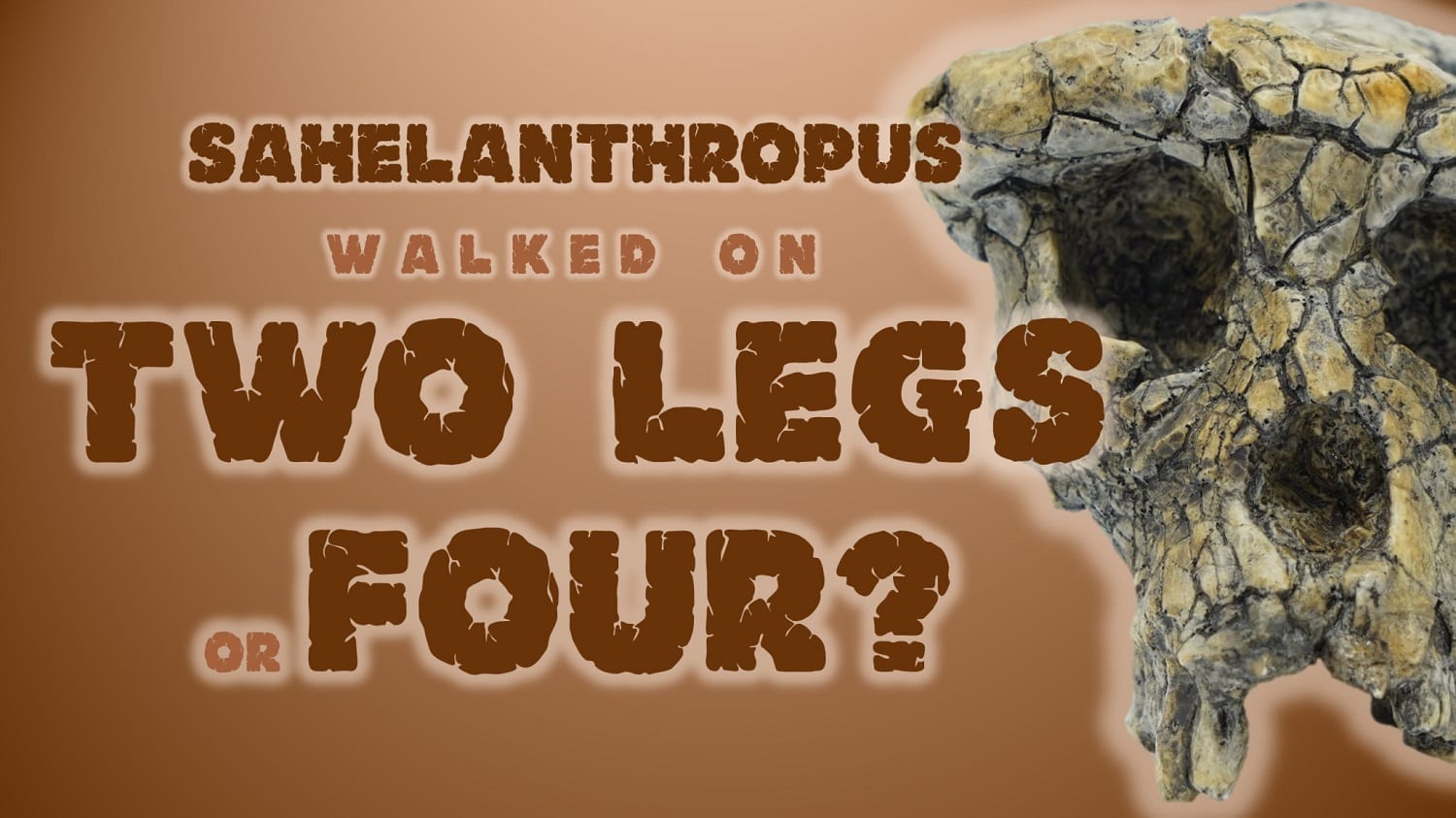[Originally published as The Mysterious Missing Femur]
Almost twenty years ago, a team of scientists led by a French researcher published their description of a new fossil that they called Sahelanthropus. It was found in Chad, at a site in the southern Sahara known as Toros-Menalla.
The big news was the skull, which we know always gets people excited. It was highly fragmented and distorted, but it had the foramen magnum (the big hole where the spinal cord comes out) moved forward on the bottom of the skull, just like it would be if the creature walked around habitually on two legs. This was part of the evidence that convinced the researchers that they had a hominin, a creature more similar to humans than to anything else alive. With a radiometric date of about 6-7 million years ago, this would be one of the oldest (if not THE oldest) hominin known from the fossil record.
Placing Sahelanthropus in the hominin group has been criticized, which again is not surprising. What is peculiar about this case is the ongoing discussion about a fossil that was not included in the original description. That bone was a femur, the large bone that connects your knee to your thigh. Since leg bones are pretty important for posture and locomotion, presumably that femur would be an important part of the discussion about how Sahelanthropus walked and whether or not it was really a hominin.
Until now, however, all we’ve had are some photographs and claims of researchers who say they saw the fossil. It’s been written about in several contexts, both in the peer reviewed literature (here), science news (here), and blogs (here). But still, until now, nothing focused directly on describing that fossil.
Thus, a new paper in Journal of Human Evolution by Roberto Macchiarelli, Aude Bergeret-Medina, Damiano Marchi, and Bernard Wood, with the innocuous title Nature and relationships of Sahelanthropus tchadensis, finally gives us a detailed look at this fossil. (Notice that this is the same Macchiarelli who got this abstract rejected in this Nature piece.)
Even though the authors admit in the paper that they do not know the current whereabouts of the fossil, they had seen the fossil firsthand, and they had detailed photographs to work with. Here is that mysterious femur, courtesy the New Scientist Twitter feed:
Our supposed earliest human relative may have walked on four legs, suggests a study of its femur, which means it may not be a hominin at all https://t.co/mostypl0Lq pic.twitter.com/Fv4HUVmalQ
— New Scientist (@newscientist) November 19, 2020
What do Macchiarelli and colleagues have to say about this fossil? First, they admit that we can’t be certain that it belongs to the same skeleton or even the same species as the skull. However, since it is most similar in form to primate thigh bones and dissimilar to carnivores (fossils of which were also found at Toros-Menalla), we can conclude it’s most likely a primate.
From there, it becomes a matter of Occam’s razor to assume that it belonged to the only primate found at that site: Sahelanthropus. It’s simpler to imagine one primate at Toros-Menalla rather than two. Occam’s razor could be wrong, of course, so that’s a bit of uncertainty.
The femur is broken at both ends, and all the information that could be gained from the ends is lost. That includes the angle of the head and the angle of the knee, both of which differ between two-legged humans and four-legged chimpanzees. So the authors did their best analysis with what they had: the shape of the shaft and the cross-section of the distal end (down by the knee). In both analyses, they found this femur was most similar to chimpanzees and was less similar to any femur from an upright walker (like us).
To my mostly untrained eye, the most striking evidence is the curvature of the femur, which is easily seen in the photograph above. A human femur is not curved in that way, and neither is the femur of any upright walker from the fossil record.
What should we conclude about this? It’s tempting to go with the headlines and simply say that Sahelanthropus didn’t walk upright and wasn’t a hominin. To do that, we’d have to follow a string of inferences:
- If the femur belongs with the skull and
- if the photographs and records faithfully represent the femur and
- if the femur shape is typical of the species and of the adults of the species and
- if hominins must be defined by their ability to walk upright,
- then Sahelanthropus (femur and skull) is not a hominin.
That’s a lot of ifs, but I think it’s a reasonable string of inferences.
This reminds me to not take one piece of evidence as definitive of much of anything in the fossil record. The position of the foramen magnum is only one piece of evidence that a creature walked upright. Likewise the shape of the femur and the form of the hip and knee. When these evidences agree, as in Little Foot, we can be pretty sure it walked habitually on two feet. When they disagree, as in the apparent case of Sahelanthropus, we have to be more uncertain.
The same goes for calling Sahelanthropus a hominin, which of course raises the question of what a “hominin” even is. From an evolutionary perspective, should we define a hominin based entirely on upright walking? Is it possible that other ape groups could also have walked upright? Is it possible that the first hominin walked on all fours?
From a creationist perspective, defining “hominin” runs into the much bigger question of what are groups of baramins? To an evolutionist, any (legitimate) classification group ought to reflect evolutionary relationship, that is to say, hominins are a branch on the evolutionary tree (just like hominoids, primates, mammals, and vertebrates are much bigger branches). Thus, it makes sense to be concerned about making sure that creatures get placed in the right groups that reflect their true evolutionary relationships.
We creationists don’t share that concern, since we do not accept the evolutionary tree connecting baramins. All we have are species, baramins, and characteristics that are more or less similar between the baramins. So does it even make sense to be picky about whether this or that fossil is a hominin, if a hominin is nothing more than a shorthand for creatures who share certain characteristics?
What a Creationist can Conclude from these Bones
What I find most interesting about this result are the mixed signals we get from the skull and femur (assuming they belong to the same species). My current research (as yet unpublished) is starting to indicate that extant chimps, bonobos, and gorillas belong to the same baramin as Australopithecus afarensis (Lucy) and A. anamensis, both of which are putative upright walkers from the fossil record of Ethiopia.
If that’s right, if modern four-legged walkers belong in the same family as extinct two-legged walkers, that would imply that we might expect creatures that mix traits of both. If the femur and skull of Toros-Menalla really do belong together as a taxon called Sahelanthropus, then that could very well fit the bill of having mixed traits: a foramen magnum of a two-legged walker and the thighbone of a four-legged walker.
One final pair of questions remain: Where is this femur, and why wasn’t it published with the original descriptions of Sahelanthropus? I don’t want to stoke the flames of conspiracy theories (we’ve had enough of that nonsense this year), but it’s pretty strange that this fossil has been ignored for so long when it seems very relevant to the most basic questions of what Sahelanthropus is.
I’ll be very, very interested to see where this goes. Hopefully we’ll find more Sahelanthropus remains to help confirm or correct these very preliminary ideas. And maybe someone will even find the missing femur.
References
Macchiarelli et al. Nature and relationships of Sahelanthropus tchadensis. J. Hum. Evol. 149, DOI 10.1016/j.jhevol.2020.102898.







